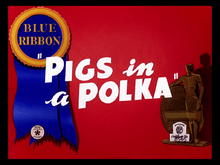Pigs in a Polka
| Pigs in a Polka | |
|---|---|
| Merrie Melodies series | |
 The August 14, 1948 Blue Ribbon reissue title card of Pigs in a Polka. | |
| Directed by | I. Freleng |
| Produced by | Leon Schlesinger |
| Voices by |
Mel Blanc Sara Berner |
| Music by | Carl W. Stalling |
| Animation by | Ken Champin |
| Studio | Leon Schlesinger Studios |
| Distributed by | Warner Bros. |
| Release date(s) | February 2, 1943 |
| Color process | Technicolor |
| Running time | 7 minutes |
| Language | English |
Pigs in a Polka is a one-reel animated cartoon short subject in the Merrie Melodies series, produced in Technicolor and released to theatres on February 2, 1943[1][2] by Warner Bros.. It was produced by Leon Schlesinger and directed by Friz Freleng, with musical supervision by Carl W. Stalling. There is very little dialogue in the cartoon aside from the Big Bad Wolf's introduction of the story and the pigs introducing themselves.
The film is a parody of two Walt Disney films: 1933 Three Little Pigs and 1940 Fantasia. The familiar story of the Three Little Pigs is set in this film to several of Brahms' "Hungarian Dances", specifically No. 5, No. 7, No. 6 and No. 17 which appear in that order. It is also part of a light-hearted, culturally subversive Merrie Melodies running joke, which would later be re-emphasized with another Fantasia parody, 1943's A Corny Concerto.
It was nominated for the 1942 Academy Award for Best Short Subject: Cartoons.
This film can be found in the Looney Tunes Golden Collection: Volume 3 disc 3, Warner Bros. Home Entertainment Academy Awards Animation Collection and several low-budget home video and DVD releases.
This is one of the 61 pre-1948 WB cartoons to fall into the public domain as United Artists did not renew the copyright in time.
Plot
After an introduction by the wolf, the plot follows the traditional story of the three little pigs. The first pig erects a wire structure, then quickly bushels straw over the structure for the house. The second pig uses hundreds of matches to make up his house. The third pig goes through the tedious task of laying bricks for his house.
After the first two pigs have quickly finished their houses, they start dancing around and laughing with each other. The wolf dresses as a gypsy and temporarily fools the pigs, but soon drops the disguise and chases them to their respective houses. With the straw house, the wolf uses a lit match to burn the house, and with the match house, he drops a solitary match on the roof, causing the house to collapse. He tries to destroy the brick house by trying to knock down the door, as well as huffing and puffing and trying to blow the house down, but he fails at this attempt.
Once the first two pigs join the third pig in his brick house, the wolf again dresses up - this time as a homeless woman playing a violin, while it's snowing outside (the 'snow' actually talcum powder held above the wolf's head on a stick). The first two pigs have pity on the wolf, and despite the third pig blocking the door, the two other pigs let the wolf in. When the wolf continues to play the violin, the third pig sees that the wolf has a record player hidden behind him. The third pig switches to the other side of the record, putting on a fast-paced dance. The wolf dances to this new tune, but loses his costume as a result. The wolf then chases the pigs up to the second floor of the house. The pigs make their escape in an elevator but when the wolf tries to use the elevator he drops into an empty shaft and falls at the feet of the pigs.
In other media
Short clips from this cartoon can be seen in the opening credits of the Futurama episodes "Mars University" and "Brannigan, Begin Again", the Everybody Hates Chris episode "Everybody Hates Gretzky", and in the movie Training Day.
References
- ↑ Beck, Jerry; Friedwald, Will (1989). Looney Tunes and Merrie Melodies: A Complete Illustrated Guide to the Warner Bros. Cartoons. New York, NY: Henry Holt and Company. p. 137. ISBN 0-8050-0894-2.
- ↑ McCall, Douglas L. (1998). Film Cartoons: A Guide to 20th Century American Animated Features and Shorts. Jefferson, NC: McFarland. p. 180. ISBN 978-0786405848.
External links
- Pigs in a Polka at the Internet Movie Database
- Pigs in a Polka at The Big Cartoon DataBase
- The short film CartoonTheater 1930s and 1950s 1 is available for free download at the Internet Archive